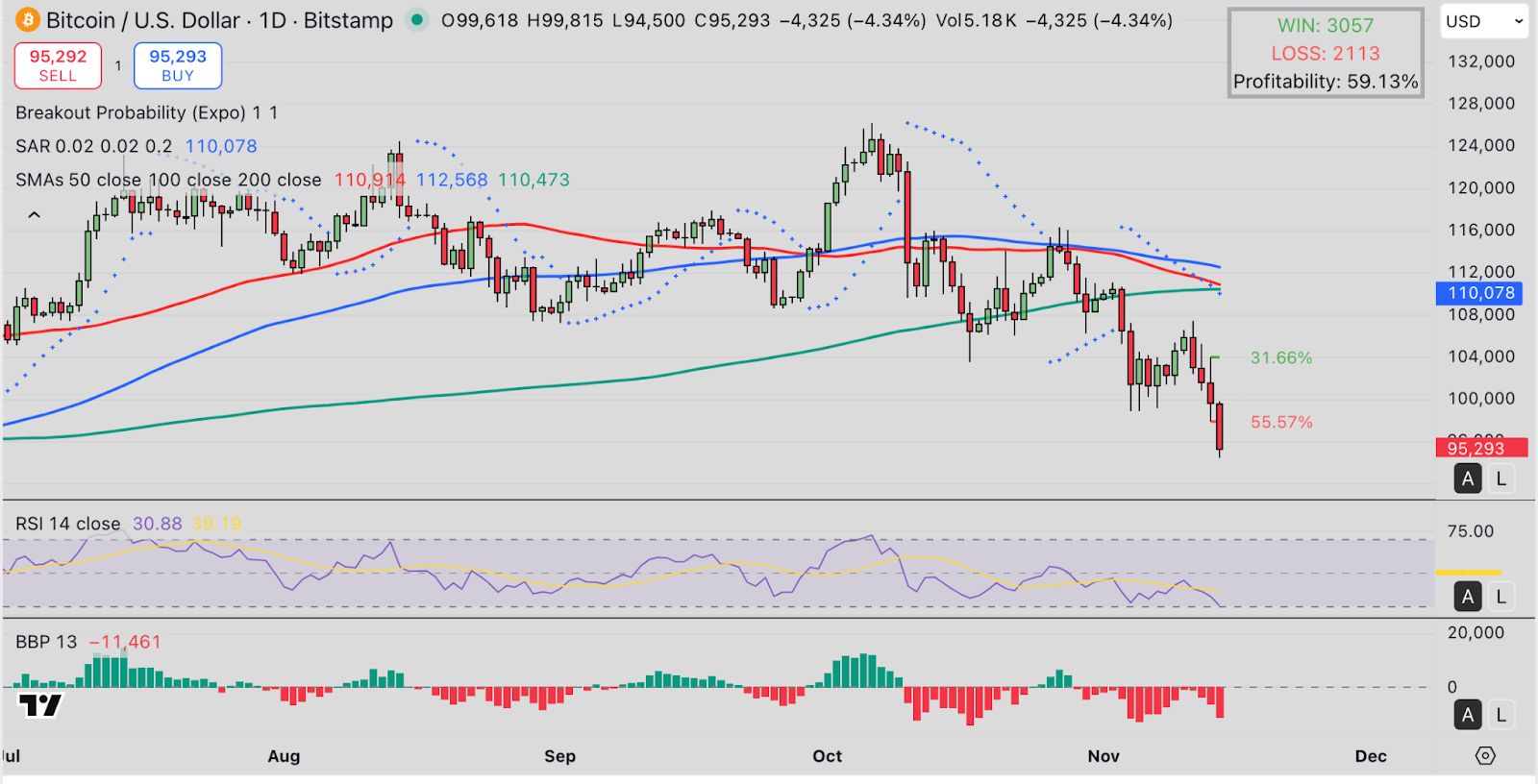Bitcoin Price Stumbles Below $95K as Liquidity Shifts and Fed Transition Drive Market Repricing
Liquidity Regime Reset: Strategist Says Fed Cuts, Policy Shifts, and Regulatory Clarity Strengthen Bitcoin’s Long-Term Thesis
Bitcoin extended its decline on Friday, falling 3% intraday and breaking below the $95,000 threshold as macroeconomic signals triggered renewed repositioning across digital-asset markets. According to James E. Thorne, Chief Market Strategist at WellingtonAltus, the latest BTC price pullback comes amid structural changes within the Federal Reserve, and rising institutional interest in Bitcoin.
Thorne argues that the U.S. government’s reopening after a 43-day shutdown and the Treasury’s renewed management of the Treasury General Account (TGA) signal an imminent injection of liquidity into financial markets.
He expects quantitative tightening to end shortly, paving the way for continued rate cuts until the federal funds rate drops toward 2.75%. In his view, the 2026 reshaping of the Federal Open Market Committee, including the replacement of Chair Jerome Powell, will mark the end of Progressive Left Keynesian influence at the Fed.
Thorne identifies a housing recession as the direct consequence of the Fed’s policy mistakes, noting that backward-looking indicators and overtightened financial conditions have distorted credit availability.
Yet despite these headwinds, he highlights surging Bitcoin adoption driven by forthcoming regulatory clarity and the unmatched digital scarcity of BTC. Institutional engagement continues to deepen as Wall Street integrates Bitcoin across trading, custody, and structured-products.
Thorne concludes that selling Bitcoin during a liquidity expansion cycle reflects persistent investor irrationality.
Bitcoin Price Forecast: Can BTC Reclaim $100K After a 55% Downside Probability Signal?
Bitcoin trades at $95,558, sliding deeper into a corrective phase as sellers maintain control. The Parabolic SAR dots remain firmly above price action, signaling continued trend weakness. The Breakout Probability model shows a 55.57% downside skew, with only 31.66% upside, reinforcing the bearish near-term structure.
Momentum remains fragile. The daily RSI sits at 31.15, near oversold but lacking any bullish divergence.

The BBP indicator prints a deep negative −11,537, confirming that bearish momentum is accelerating rather than stabilizing. Moving averages offer little relief, with BTC trading well below the 50-day, 100-day, and 200-day SMAs , all clustered around $110,000 to $112,000 now acting as layered resistance.
A clean bounce from $94,500 is critical to avoid a deeper slide toward $92,000, the next high-liquidity support zone. If buyers defend this region, a recovery toward $100,000 becomes feasible, followed by a retest of $105,000 should momentum improve. The bullish continuation setup only activates if BTC breaks above $110,078, the SAR and SMA confluence level that currently caps the structure.
Related: ‘Good News Is Bad News’: Why the Shutdown’s End Is Hurting Bitcoin
Invalidation occurs on a daily close below $92,000, which would confirm a broader bear cycle extension, potentially exposing $88,500 next.
Disclaimer: The content of this article solely reflects the author's opinion and does not represent the platform in any capacity. This article is not intended to serve as a reference for making investment decisions.
You may also like
Bitcoin Updates: Corporate Bitcoin Holdings Transform Crypto Industry While MicroStrategy Stands Strong Amid Market Fluctuations
- MicroStrategy's Michael Saylor denied Bitcoin sale rumors, reaffirming the company's aggressive BTC accumulation strategy despite market volatility. - The firm holds 641,692 BTC ($61.3B) but faces liquidity risks as its market value dips below holdings' net asset value for the first time. - Leveraged debt ($47.5B) and falling BTC prices raise concerns about a "death spiral," though analysts suggest forced sales are unlikely until 2027. - Saylor's bullish stance contrasts with market jitters, as corporate

Bitcoin Updates: Harvard’s Investment in Bitcoin Challenges Previous Doubts as More Institutions Join
- Harvard University tripled its Bitcoin stake in IBIT, now holding $442.8M in the ETF, making it the fund's 16th-largest holder. - The move defies past skepticism from Harvard economists like Kenneth Rogoff, who once predicted Bitcoin would fall to "$100 rather than $100,000". - Institutional adoption grows as Abu Dhabi's Al Warda and Emory University also boosted Bitcoin ETF holdings, despite recent market volatility and outflows. - Harvard's 0.6% Bitcoin allocation in its $57B portfolio highlights crypt

Bitcoin Updates: Bitcoin Drops, Harvard's $364 Million ETF Investment Shows Institutional Commitment
- Harvard University increased its BlackRock IBIT Bitcoin ETF stake by 257% to $364.4M, becoming a top institutional holder. - The $50B endowment also doubled gold ETF holdings, treating both assets as inflation hedges amid macroeconomic uncertainty. - Emory and Abu Dhabi's Al Warda similarly boosted crypto-linked ETFs, signaling institutional confidence in regulated digital assets. - Analysts highlight Harvard's ETF adoption as rare validation, with U.S. spot Bitcoin ETFs attracting $60.8B in inflows sinc

Astar 2.0's Tactical Rollout and Its Impact on DeFi Advancements
- Astar 2.0 introduces institutional-grade DeFi architecture with 6-second block times and 150,000 TPS via Polkadot's async protocol. - Cross-chain interoperability with LayerZero/CCIP enables seamless asset transfers across Ethereum , BSC, and Polkadot ecosystems. - Strategic partnerships with Mizuho Bank, Casio, and Japan Airlines demonstrate real-world applications in CBDCs, logistics, and digital rewards. - $3.16M institutional ASTR purchase and 20% QoQ wallet growth highlight growing confidence in its

